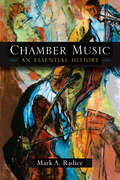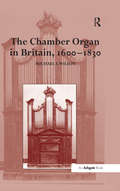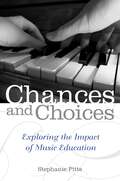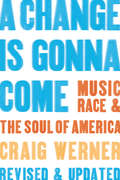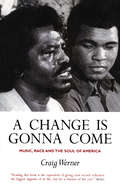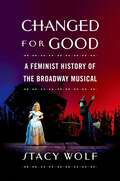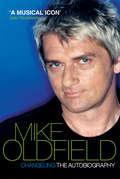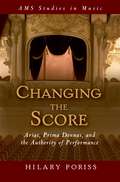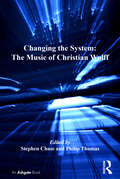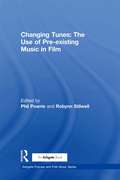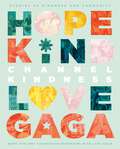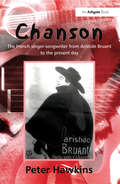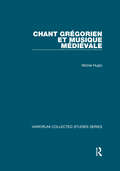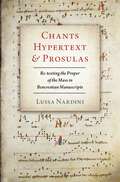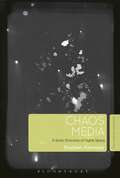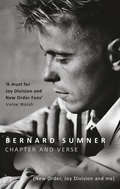- Table View
- List View
Chamber Music: An Essential History
by Mark A RadiceIntended for the music student, the professional musician, and the music lover, Chamber Music: An Essential History covers repertoire from the Renaissance to the present, crossing genres to include string quartets, piano trios, clarinet quintets, and other groupings. Mark A. Radice gives a thorough overview and history of this long-established and beloved genre, typically performed by groups of a size to fit into spaces such as homes or churches and tending originally toward the string and wind instruments rather than percussion. Radice begins with chamber music's earliest expressions in the seventeenth century, discusses its most common elements in terms of instruments and compositional style, and then investigates how those elements play out across several centuries of composers- among them Mozart, Bach, Haydn, and Brahms- and national interpretations of chamber music. While Chamber Music: An Essential History is intended largely as a textbook, it will also find an audience as a companion volume for musicologists and fans of classical music, who may be interested in the background to a familiar and important genre.
The Chamber Organ in Britain, 1600-1830
by Michael I. WilsonThe first edition of The English Chamber Organ was published in 1968. This new, revised edition takes into account the considerable research into chamber organs that has taken place over the last thirty years. Much of the book has been completely rewritten and expanded, and it includes a number of organs not detailed in the first edition. As its revised title suggests, this new edition covers foreign-make imports as well as British-made organs that were sent overseas. Part one comprises a series of chapters that cover the history of the chamber organ, its origins and development. Part two provides a general introduction to the construction of organs, while part three gives detailed descriptions of 196 British chamber organs, with information on their location, specifications, design, and suggestions for further reading. As a domestic instrument the chamber organ was often perceived to be as much a piece of furniture as an item of musical equipment. The Chamber Organ in Britain offers an assessment of the organ as both a musical instrument and as a decorative icon.
The Chamber Organ in Britain, 1600-1830
by Michael I. WilsonThe first edition of The English Chamber Organ was published in 1968. This new, revised edition takes into account the considerable research into chamber organs that has taken place over the last thirty years. Much of the book has been completely rewritten and expanded, and it includes a number of organs not detailed in the first edition. As its revised title suggests, this new edition covers foreign-make imports as well as British-made organs that were sent overseas. Part one comprises a series of chapters that cover the history of the chamber organ, its origins and development. Part two provides a general introduction to the construction of organs, while part three gives detailed descriptions of 196 British chamber organs, with information on their location, specifications, design, and suggestions for further reading. As a domestic instrument the chamber organ was often perceived to be as much a piece of furniture as an item of musical equipment. The Chamber Organ in Britain offers an assessment of the organ as both a musical instrument and as a decorative icon.
Chances and Choices: Exploring the Impact of Music Education
by Stephanie PittsIn Chances and Choices, Stephanie Pitts surveys the aims and impact of formative musical experiences, evaluating the extent to which music education of various kinds provides a foundation for lifelong involvement and interest in music. Pitts draws upon rich qualitative data from her own extensive original study of over 100 adults with an active interest in music in the UK and Italy to address several key themes in the study of music education. Intertwined with discussion of topics such as music education policy and the role that music teachers and other role models play in nurturing musicians are first person 'interludes' that showcase the stories and voices of the research participants as they reflect upon the influences and opportunities that shaped their musical life histories. Pitts' analysis adds valuable context to these stories, illuminating the historical and contemporary debates about music education and proposing ways in which school music might better prepare young people for continued participation in music throughout their lives. A companion website contains Pitts' data sets and analytical frameworks; the website also features an interactive database through which readers can share their own musical life histories and search others that have been contributed there. Shedding new light on the long-term effects of music education, Chances and Choices is an important resource to understand how we can encourage lasting engagement with music and other cultural activities in every individual.
Chances and Choices: Exploring the Impact of Music Education
by Stephanie PittsIn Chances and Choices, Stephanie Pitts surveys the aims and impact of formative musical experiences, evaluating the extent to which music education of various kinds provides a foundation for lifelong involvement and interest in music. Pitts draws upon rich qualitative data from her own extensive original study of over 100 adults with an active interest in music in the UK and Italy to address several key themes in the study of music education. Intertwined with discussion of topics such as music education policy and the role that music teachers and other role models play in nurturing musicians are first person 'interludes' that showcase the stories and voices of the research participants as they reflect upon the influences and opportunities that shaped their musical life histories. Pitts' analysis adds valuable context to these stories, illuminating the historical and contemporary debates about music education and proposing ways in which school music might better prepare young people for continued participation in music throughout their lives. A companion website contains Pitts' data sets and analytical frameworks; the website also features an interactive database through which readers can share their own musical life histories and search others that have been contributed there. Shedding new light on the long-term effects of music education, Chances and Choices is an important resource to understand how we can encourage lasting engagement with music and other cultural activities in every individual.
A Change Is Gonna Come: Music, Race & the Soul of America
by Craig Werner". . . extraordinarily far-reaching. . . . highly accessible." —Notes "No one has written this way about music in a long, long time. Lucid, insightful, with real spiritual, political, intellectual, and emotional grasp of the whole picture. A book about why music matters, and how, and to whom." —Dave Marsh, author of Louie, Louie and Born to Run: The Bruce Springsteen Story "This book is urgently needed: a comprehensive look at the various forms of black popular music, both as music and as seen in a larger social context. No one can do this better than Craig Werner." —Henry Louis Gates, Jr., W.E.B. Du Bois Professor of the Humanities, Harvard University "[Werner has] mastered the extremely difficult art of writing about music as both an aesthetic and social force that conveys, implies, symbolizes, and represents ideas as well as emotion, but without reducing its complexities and ambiguities to merely didactic categories." —African American Review A Change Is Gonna Come is the story of more than four decades of enormously influential black music, from the hopeful, angry refrains of the Freedom movement, to the slick pop of Motown; from the disco inferno to the Million Man March; from Woodstock's "Summer of Love" to the war in Vietnam and the race riots that inspired Marvin Gaye to write "What's Going On." Originally published in 1998, A Change Is Gonna Come drew the attention of scholars and general readers alike. This new edition, featuring four new and updated chapters, will reintroduce Werner's seminal study of black music to a new generation of readers. Craig Werner is Professor of Afro-American Studies at the University of Wisconsin, and author of many books, including Playing the Changes: From Afro-Modernism to the Jazz Impulse and Up Around the Bend: An Oral History of Creedence Clearwater Revival. His most recent book is Higher Ground: Stevie Wonder, Aretha Franklin, Curtis Mayfield, and the Rise and Fall of American Soul.
A Change Is Gonna Come: Music, Race And The Soul Of America
by Craig WernerA Change is Gonna Come chronicles more than forty years of black music: from the hopeful, angry refrains of the Freedom movement to the slick pop of Motown; from Woodstock and the 'Summer of Love' to Vietnam and the race riots; from disco inferno to the Million Man March. This is an insightful and riveting study which looks at the place black music occupies in social history, its battle for the desegregation of popular music and its contribution to social change outside the recording studio
Changed for Good: A Feminist History of the Broadway Musical
by Stacy WolfFrom Adelaide in "Guys and Dolls" to Nina in "In the Heights" and Elphaba in "Wicked," female characters in Broadway musicals have belted and crooned their way into the American psyche. In this lively book, Stacy Wolf illuminates the women of American musical theatre - performers, creators, and characters -- from the start of the cold war to the present day, creating a new, feminist history of the genre. Moving from decade to decade, Wolf first highlights the assumptions that circulated about gender and sexuality at the time. She then looks at the leading musicals to stress the key aspects of the plays as they relate to women, and often finds overlooked moments of empowerment for female audience members. The musicals discussed here are among the most beloved in the canon--"West Side Story," "Cabaret," "A Chorus Line," "Phantom of the Opera," and many others--with special emphasis on the blockbuster "Wicked." Along the way, Wolf demonstrates how the musical since the mid-1940s has actually been dominated by women--women onstage, women in the wings, and women offstage as spectators and fans.
Changed for Good: A Feminist History of the Broadway Musical
by Stacy WolfFrom Adelaide in "Guys and Dolls" to Nina in "In the Heights" and Elphaba in "Wicked," female characters in Broadway musicals have belted and crooned their way into the American psyche. In this lively book, Stacy Wolf illuminates the women of American musical theatre - performers, creators, and characters -- from the start of the cold war to the present day, creating a new, feminist history of the genre. Moving from decade to decade, Wolf first highlights the assumptions that circulated about gender and sexuality at the time. She then looks at the leading musicals to stress the key aspects of the plays as they relate to women, and often finds overlooked moments of empowerment for female audience members. The musicals discussed here are among the most beloved in the canon--"West Side Story," "Cabaret," "A Chorus Line," "Phantom of the Opera," and many others--with special emphasis on the blockbuster "Wicked." Along the way, Wolf demonstrates how the musical since the mid-1940s has actually been dominated by women--women onstage, women in the wings, and women offstage as spectators and fans.
Changeling: The Autobiography of Mike Oldfield
by Mike OldfieldBorn without social instincts many people take for granted, brought up in a troubled environment and possessed with an extraordinary musical talent, Mike Oldfield was thrust into the spotlight at the tender age of nineteen. His first album Tubular Bells went on to sell fifteen million copies worldwide and catapulted him into a stardom he was ill-equipped to cope with.From growing up with an alcoholic mother, to his feelings of alienation and struggles with depression, this book takes Mike from his early years, through his staggering fame, his broken marriages, years as a recluse, his rebirth experience at a controversial Exegesis seminar and beyond. Mike Oldfield has been on a journey few of us could ever imagine, and offers a message of hope to anybody who feels they live on the edge of society.
Changing the Score: Arias, Prima Donnas, and the Authority of Performance (AMS Studies in Music)
by Hilary PorissThis study seeks to explore the role and significance of aria insertion, the practice that allowed singers to introduce music of their own choice into productions of Italian operas. Each chapter investigates the art of aria insertion during the nineteenth century from varying perspectives, beginning with an overview of the changing fortunes of the practice, followed by explorations of individual prima donnas and their relationship with particular insertion arias: Carolina Ungher's difficulties in finding a "perfect" aria to introduce into Donizetti's Marino Faliero; Guiditta Pasta's performance of an aria from Pacini's Niobe in a variety of operas, and the subsequent fortunes of that particular aria; Maria Malibran's interpolation of Vaccai's final scene from Giulietta e Romeo in place of Bellini's original setting in his I Capuleti e i Montecchi; and Adelina Patti's "mini-concerts" in the lesson scene of Il barbiere di Siviglia. The final chapter provides a treatment of a short story, "Memoir of a Song," narrated by none other than an insertion aria itself, and the volume concludes with an appendix containing the first modern edition of this short story, a narrative that has lain utterly forgotten since its publication in 1849. This book covers a wide variety of material that will be of interest to opera scholars and opera lovers alike, touching on the fluidity of the operatic work, on the reception of the singers, and on the shifting and hardening aesthetics of music criticism through the period.
Changing the System: The Music of Christian Wolff
by Stephen ChaseChristian Wolff is a composer who has followed a distinctive path often at the centre of avant-garde activity working alongside figures such as John Cage, Merce Cunningham, and Cornelius Cardew. In a career spanning sixty years, he has produced a significant and influential body of work that has aimed to address, in a searching and provocative manner, what it means to be an experimental and socially aware artist. This book provides a wide-ranging introduction to a composer often overlooked despite his influence upon many of the major figures in new music since the 1950s from Cage to John Zorn to the new wave of experimentalists across the globe. As the first detailed analysis of the music of this prolific and highly individual composer, Changing the System: The Music of Christian Wolff contains contributions from leading experts in the field of new and experimental music, as well as from performers and composers who have worked with Wolff. The reception of Wolff's music is discussed in relation to the European avant-garde and also within the context of Wolff's association with Cage and Feldman. Music from his earliest compositions of the 1950s, the highly indeterminate scores, the politically-inspired pieces up to the most recent works are discussed in detail, both in relation to their compositional techniques, general aesthetic development, and matters of performance. The particular challenges and aesthetic issues arising from Wolff's idiosyncratic notations and the implications for performers are a central theme. Likewise, the ways in which Wolff's political persuasions - which arguably account for some of the notational methods he chooses - have been worked out through his music, are examined. With a foreword by his close associate Michael Parsons, this is a valuable addition to experimental music literature.
Changing the System: The Music of Christian Wolff
by Stephen ChaseChristian Wolff is a composer who has followed a distinctive path often at the centre of avant-garde activity working alongside figures such as John Cage, Merce Cunningham, and Cornelius Cardew. In a career spanning sixty years, he has produced a significant and influential body of work that has aimed to address, in a searching and provocative manner, what it means to be an experimental and socially aware artist. This book provides a wide-ranging introduction to a composer often overlooked despite his influence upon many of the major figures in new music since the 1950s from Cage to John Zorn to the new wave of experimentalists across the globe. As the first detailed analysis of the music of this prolific and highly individual composer, Changing the System: The Music of Christian Wolff contains contributions from leading experts in the field of new and experimental music, as well as from performers and composers who have worked with Wolff. The reception of Wolff's music is discussed in relation to the European avant-garde and also within the context of Wolff's association with Cage and Feldman. Music from his earliest compositions of the 1950s, the highly indeterminate scores, the politically-inspired pieces up to the most recent works are discussed in detail, both in relation to their compositional techniques, general aesthetic development, and matters of performance. The particular challenges and aesthetic issues arising from Wolff's idiosyncratic notations and the implications for performers are a central theme. Likewise, the ways in which Wolff's political persuasions - which arguably account for some of the notational methods he chooses - have been worked out through his music, are examined. With a foreword by his close associate Michael Parsons, this is a valuable addition to experimental music literature.
Changing Tunes: The Use of Pre-existing Music in Film
by Robynn StilwellThe study of pre-existing film music is now a well-established part of Film Studies, covering 'classical' music and popular music. Generally, these broad musical types are studied in isolation. This anthology brings them together in twelve focused case studies by a range of scholars, including Claudia Gorbman, Jeongwon Joe, Raymond Knapp, and Timothy Warner. The first section explores art music, both instrumental and operatic; it revolves around the debate on the relation between the aural and visual tracks, and whether pre-existing music has an integrative function or not. The second section is devoted to popular music in film, and shows how very similar the functions of popular music in film are to the supposedly more 'elite' classical music and opera. Case studies in part 1: Eyes Wide Shut, Raging Bull, Brief Encounter, Detective, The Godfather Part III, three versions of the Carmen story (DeMille's, Preminger's and Rosi's), Amadeus, The Birth of a Nation, M: Eine Stadt sucht einen MA rder, Needful Things, Rat Race. Case studies in part 2: various films by AlmodA^3var, Young Frankenstein, Pulp Fiction, Trainspotting, Amelie, High Fidelity, Ghost World, Heavenly Creatures, The Virgin Suicides, and the video Timber by Coldcut.
Changing Tunes: The Use of Pre-existing Music in Film
by Robynn StilwellThe study of pre-existing film music is now a well-established part of Film Studies, covering 'classical' music and popular music. Generally, these broad musical types are studied in isolation. This anthology brings them together in twelve focused case studies by a range of scholars, including Claudia Gorbman, Jeongwon Joe, Raymond Knapp, and Timothy Warner. The first section explores art music, both instrumental and operatic; it revolves around the debate on the relation between the aural and visual tracks, and whether pre-existing music has an integrative function or not. The second section is devoted to popular music in film, and shows how very similar the functions of popular music in film are to the supposedly more 'elite' classical music and opera. Case studies in part 1: Eyes Wide Shut, Raging Bull, Brief Encounter, Detective, The Godfather Part III, three versions of the Carmen story (DeMille's, Preminger's and Rosi's), Amadeus, The Birth of a Nation, M: Eine Stadt sucht einen MA rder, Needful Things, Rat Race. Case studies in part 2: various films by AlmodA^3var, Young Frankenstein, Pulp Fiction, Trainspotting, Amelie, High Fidelity, Ghost World, Heavenly Creatures, The Virgin Suicides, and the video Timber by Coldcut.
Channel Kindness: Stories of Kindness and Community
by Born This Way Foundation Reporters with Lady Gaga Lady GagaChannel Kindness is a collection of fifty-one stories of kindness, bravery, and resilience from young people all over the world collected by the Born This Way Foundation and introduced by Lady Gaga.For Lady Gaga, kindness is the driving force behind everything she says and does. The quiet power of kindness can change the way we view one another, our communities, and even ourselves. She embodies this mission, and through her work, brings more kindness into our world every single day.Lady Gaga has always believed in the importance of being yourself, being kind to yourself and others, no matter who they are or where they come from. With that sentiment in mind, she and her mother, Cynthia Germanotta, founded Born This Way Foundation, a nonprofit organization dedicated to making the world a kinder and braver place. Through the years, they’ve collected stories of kindness, bravery, and resilience from young people all over the world, proving that kindness truly is the universal language. And now, we invite you to read these stories and follow along as each and every young author finds their voice, just as Lady Gaga has found hers.Within these pages, you’ll meet young changemakers who found their inner strength, who prevailed in the face of bullies, who started their own social movements, who decided to break through the mental health stigma and share how they felt, who created safe spaces for LGBTQ+ youth, and who have embraced kindness with every fiber of their being by helping others without the expectation of anything in return.Individually and collectively, the stories collected here prove that kindness not only saves lives but builds community. Kindness is inclusion, it is pride, it is empathy, it is compassion, it is self-respect and it is the guiding light to love. Kindness is always transformational, and its never-ending ripples result in even more kind acts that can change our lives, our communities, and our world.
Chanson: The French Singer-Songwriter from Aristide Bruant to the Present Day
by Peter HawkinsEn France, tout finit par des chansons' is the well-known phrase which sums up the importance of chanson for the French. A song tradition that goes back to the Middle Ages and troubadours of the twelfth and thirteenth centuries, chanson is part of the texture of everyday life in France - a part of the national identity and a barometer of popular taste. In this first study of chanson in English, Peter Hawkins examines the background to the genre and the difficulties in defining what is and what is not chanson. The focus then moves to the development of the singer-songwriter of chanson from 1880 to the present day. This period saw the emergence of national icons from Aristide Bruant at the end of the nineteenth century through to internationally recognized musicians such as Jacques Brel and Serge Gainsbourg. Each of these figures used chanson to express the particular moral dilemmas, tragic situations and moments of euphoria particular to themselves and their times. The book provides bibliographies, discographies and details of video recordings for each of the singer-songwriters that it discusses. It is both an essential reference guide to the genre and a useful case history of the adaptation of an ancient form to the demands of the modern mass media.
Chanson: The French Singer-Songwriter from Aristide Bruant to the Present Day
by Peter HawkinsEn France, tout finit par des chansons' is the well-known phrase which sums up the importance of chanson for the French. A song tradition that goes back to the Middle Ages and troubadours of the twelfth and thirteenth centuries, chanson is part of the texture of everyday life in France - a part of the national identity and a barometer of popular taste. In this first study of chanson in English, Peter Hawkins examines the background to the genre and the difficulties in defining what is and what is not chanson. The focus then moves to the development of the singer-songwriter of chanson from 1880 to the present day. This period saw the emergence of national icons from Aristide Bruant at the end of the nineteenth century through to internationally recognized musicians such as Jacques Brel and Serge Gainsbourg. Each of these figures used chanson to express the particular moral dilemmas, tragic situations and moments of euphoria particular to themselves and their times. The book provides bibliographies, discographies and details of video recordings for each of the singer-songwriters that it discusses. It is both an essential reference guide to the genre and a useful case history of the adaptation of an ancient form to the demands of the modern mass media.
Chant grégorien et musique médiévale (Variorum Collected Studies)
by Michel HugloThis is the third in a set of four collections of articles by Michel Huglo to be published in the Variorum series. It brings together the studies of Gregorian chant and of later monophonic and polyphonic additions to the earlier repertory that occupied Huglo in the second phase of his research. Represented here are articles on the Kyrie, the introit tropes of St-Gall, an elegy for William the Conqueror (d. 1087), the versus by Venantius Fortunatus for the cathedral of Paris, the liturgical dramas of Fleury, early organum, the Mass of Tournai, and, finally, the Requiem by Eustache Du Caurroy. Ce volume des articles de Michel Huglo est le troisième de la série de quatre dans la collection Variorum. Il réunit des études sur le chant grégorien et sur les additions de pièces monodiques ou polyphoniques faites au répertoire primitif, sujets qui ont occupé Michel Huglo dans la seconde phase de sa carrière de chercheur. Dans ce volume, le lecteur trouvera des articles sur le Kyrie, les tropes d'introït de St-Gall, l'élégie pour Guillaume le Conquérant (d. 1087), les versus de Venance Fortunat pour la cathédrale de Paris, les drames liturgiques de Fleury, les débuts de l'organum, la Messe de Tournai, et finalement le Requiem d'Eustache Du Caurroy.
Chant grégorien et musique médiévale (Variorum Collected Studies)
by Michel HugloThis is the third in a set of four collections of articles by Michel Huglo to be published in the Variorum series. It brings together the studies of Gregorian chant and of later monophonic and polyphonic additions to the earlier repertory that occupied Huglo in the second phase of his research. Represented here are articles on the Kyrie, the introit tropes of St-Gall, an elegy for William the Conqueror (d. 1087), the versus by Venantius Fortunatus for the cathedral of Paris, the liturgical dramas of Fleury, early organum, the Mass of Tournai, and, finally, the Requiem by Eustache Du Caurroy. Ce volume des articles de Michel Huglo est le troisième de la série de quatre dans la collection Variorum. Il réunit des études sur le chant grégorien et sur les additions de pièces monodiques ou polyphoniques faites au répertoire primitif, sujets qui ont occupé Michel Huglo dans la seconde phase de sa carrière de chercheur. Dans ce volume, le lecteur trouvera des articles sur le Kyrie, les tropes d'introït de St-Gall, l'élégie pour Guillaume le Conquérant (d. 1087), les versus de Venance Fortunat pour la cathédrale de Paris, les drames liturgiques de Fleury, les débuts de l'organum, la Messe de Tournai, et finalement le Requiem d'Eustache Du Caurroy.
Chants, Hypertext, and Prosulas: Re-texting the Proper of the Mass in Beneventan Manuscripts
by Luisa NardiniThe liturgical chant sung in the churches of Southern Italy between the ninth and thirteenth centuries reflects the multiculturalism of a territory in which Romans, Franks, Lombards, Byzantines, Normans, Jews, and Muslims were all present with various titles and political roles. Chants, Hypertext, and Prosulas examines a specific genre, the prosulas that were composed to embellish and expand pre-existing liturgical chants. Widespread in medieval Europe, prosulas were highly cultivated in southern Italy, especially by the nuns, monks, and clerics of the city of Benevento. These texts shed light on the creativity of local cantors to provide new meanings to the liturgy in accordance with contemporary waves of religious spirituality, and to experiment with a novel musical style in which a syllabic setting is paired with the free-flowing melody of the parent chant. In their representing an epistemological 'beyond', and in their interconnectedness with the parent chant, these prosulas can be likened to modern hypertexts. In this book, author Luisa Nardini presents the first comprehensive study to integrate textual and musical analyses of liturgical prosulas as they were recorded in Beneventan manuscripts. Discussing general features of prosulas in southern Italy and their relation to contemporary liturgical genres (e.g., tropes, sequences, hymns), Nardini firmly situates Beneventan prosulas within the broader context of European musical history. An invaluable reference for the field, Chants, Hypertext, and Prosulas provides a new understanding of the phonetic and morphological transformations of the Latin language in medieval Italy, and clarifies the use of perennially puzzling features of Beneventan notation.
Chants, Hypertext, and Prosulas: Re-texting the Proper of the Mass in Beneventan Manuscripts
by Luisa NardiniThe liturgical chant sung in the churches of Southern Italy between the ninth and thirteenth centuries reflects the multiculturalism of a territory in which Romans, Franks, Lombards, Byzantines, Normans, Jews, and Muslims were all present with various titles and political roles. Chants, Hypertext, and Prosulas examines a specific genre, the prosulas that were composed to embellish and expand pre-existing liturgical chants. Widespread in medieval Europe, prosulas were highly cultivated in southern Italy, especially by the nuns, monks, and clerics of the city of Benevento. These texts shed light on the creativity of local cantors to provide new meanings to the liturgy in accordance with contemporary waves of religious spirituality, and to experiment with a novel musical style in which a syllabic setting is paired with the free-flowing melody of the parent chant. In their representing an epistemological 'beyond', and in their interconnectedness with the parent chant, these prosulas can be likened to modern hypertexts. In this book, author Luisa Nardini presents the first comprehensive study to integrate textual and musical analyses of liturgical prosulas as they were recorded in Beneventan manuscripts. Discussing general features of prosulas in southern Italy and their relation to contemporary liturgical genres (e.g., tropes, sequences, hymns), Nardini firmly situates Beneventan prosulas within the broader context of European musical history. An invaluable reference for the field, Chants, Hypertext, and Prosulas provides a new understanding of the phonetic and morphological transformations of the Latin language in medieval Italy, and clarifies the use of perennially puzzling features of Beneventan notation.
Chaos Media: A Sonic Economy of Digital Space
by Stephen KennedyThe contemporary media landscape might be described in simple terms as a digital terrain where real and virtual worlds collide. Stephen Kennedy investigates the concept of our digital space leading up to the digital turn of the 1990s to fully understand how our perceptions of orientation in space in time was altered. Chaos Media: A Sonic Economy of Digital Space re-thinks the five fundamental paths to our contemporary understanding of the digital age: cultural, political, economic, scientific, and aesthetic, and ties them together to form a coherent whole in order to demonstrate how critical thinking can be reconfigured using a methodological approach that uses 'chaos' and 'complexity' as systematic tools for studying contemporary mediated space. Kennedy introduces the concept of Sonic Economy, a methodology that allows for a critical engagement with the heterogeneous elements of an information society wherein the dispersion of discrete elements is manifest but not always clearly visible.
Chaos Media: A Sonic Economy of Digital Space
by Stephen KennedyThe contemporary media landscape might be described in simple terms as a digital terrain where real and virtual worlds collide. Stephen Kennedy investigates the concept of our digital space leading up to the digital turn of the 1990s to fully understand how our perceptions of orientation in space in time was altered. Chaos Media: A Sonic Economy of Digital Space re-thinks the five fundamental paths to our contemporary understanding of the digital age: cultural, political, economic, scientific, and aesthetic, and ties them together to form a coherent whole in order to demonstrate how critical thinking can be reconfigured using a methodological approach that uses 'chaos' and 'complexity' as systematic tools for studying contemporary mediated space. Kennedy introduces the concept of Sonic Economy, a methodology that allows for a critical engagement with the heterogeneous elements of an information society wherein the dispersion of discrete elements is manifest but not always clearly visible.
Chapter and Verse - New Order, Joy Division and Me: New Order, Joy Division And Me
by Bernard SumnerFounding member and guitarist of Joy Division and the lead singer of New Order, Bernard Sumner has been famous over the years for his reticence. Until now… An integral part of the Manchester music scene since the late 1970s, his is the definitive version of the events that created two of the most influential bands of all time. Chapter and Verse includes a vivid and illuminating account of Bernard’s Salford childhood, the early days of Joy Division, the band’s enormous critical and popular success, and the subsequent tragic death of Ian Curtis. Bernard describes the formation of New Order, takes us behind the scenes at the birth of classics such as 'Blue Monday' and gives his first-hand account of the ecstasy and the agony of the Haçienda days.Sometimes moving, often hilarious and occasionally completely out of control, this is a tale populated by some of the most colourful and creative characters in music history, such as Ian Curtis, Tony Wilson, Rob Gretton and Martin Hannett. Others have told parts of the story, in film and book form. Now, for the first time, Bernard Sumner gives you chapter and verse.
